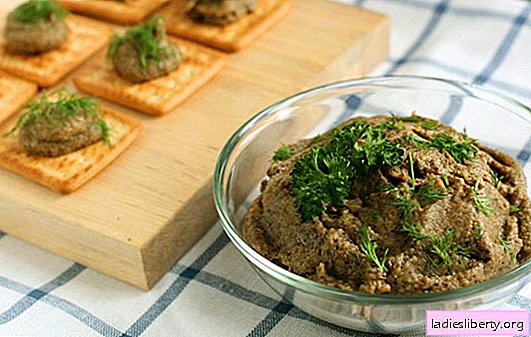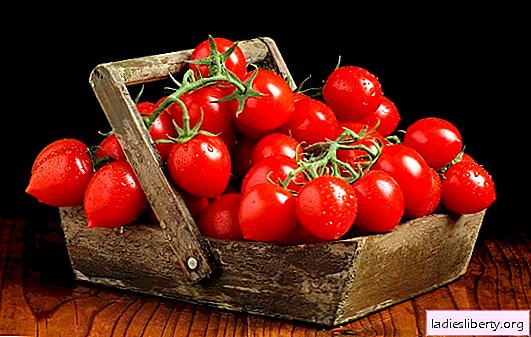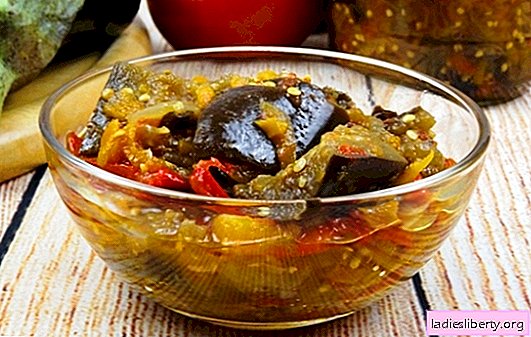
Mushroom dishes are the decoration of Russian cuisine, but it is no secret that the onset of progress and urbanization is gradually reducing the number of mushroom dishes in our diet. The endless possibilities to collect the cleanest and most edible mushrooms, to cook a lot of dishes from them all year round, which were almost the main diet of their ancestors, are gradually becoming a thing of the past.
Even having bought mushrooms, many housewives can cook only 3-5 recipes for dishes, which include mushrooms. Only real mushroom pickers know almost everything about mushrooms: what mushrooms and at what time you need to collect, how much boletus, mushrooms, russules need to be cooked, which mushrooms are ideal for salting, pickling, drying, stewing, what products do they combine perfectly with? We will try, at least, to slightly correct this situation.
Boiled mushroom caviar - basic technological principles
When preserving food, first of all, pay special attention to the safety of harvested products - this requirement doubles for canned mushroom dishes. Let us formulate briefly the basic rules of mushroom canning:
• The main principle of canning, providing long-term storage of products is the sterility of containers, careful sorting of ingredients with the removal of dirt, traces of spoilage of vegetables. Shelf life is increased by pasteurization, due to which harmful microorganisms are destroyed. The duration of pasteurization depends on the volume of cans, the heating temperature, the degree of preliminary heat treatment of the products.
• Mushrooms have a dense texture and retain their shape even after prolonged cooking, but also take into account the degree of digestion of other components that make up the dish: the consistency of caviar components in the finished dish should be the same.
• When stewing vegetables and mushrooms, consisting mainly of water, retain at least 50% moisture. For workpieces, use purified water.
• The tightness of the capping protects the workpiece from the access of air, which together with the products contributes to the development of pathogenic microorganisms. Therefore, you need to carefully check the quality of corking cans.
• If the procurement of products occurs without pasteurization, it is necessary to increase the content of natural preservatives in the preparations: salt, acetic acid, sugar. But such a technique is sometimes not very suitable, because it significantly changes the taste of the workpiece not for the better.
• When using an unfamiliar recipe for the first time - do not take risks, it is better to pasteurize the workpiece to avoid unnecessary troubles, even if the recipes emphasize that everything is checked.
• Some natural spices, in addition to taste and aroma, also have an antimicrobial effect: hot pepper, turmeric, bay leaf, juniper and other natural spices. Since different artificial stabilizers are not used in home canning, as in production, it is necessary to take into account the properties of spices in the process of home cooking.
• It is better to add fresh spicy herbs during canning 5-10 minutes before the end of cooking or stewing, in order to better preserve their aroma in a jar.
• If you are not well versed in the types of mushrooms, then just buy those that are grown in greenhouses: champignons, oyster mushrooms, some types of honey mushrooms. Of course, the taste and smell of caviar from such mushrooms will be less saturated, but you don’t have to worry about safety for health - these mushrooms can be safely used for any dishes without preliminary boiling.
Mushroom caviar in a jar or in the freezer is an opportunity to quickly cook pies or pizza, soup, stuffed cabbage, stuffed eggplants, zucchini or tomatoes, add it to meat hodgepodge or use to make porridges, beans.
1. Mushroom caviar from boiled mushrooms - a preparation for soups from mushrooms
Ingredients:
Honey mushrooms 5 kg
Onion 1.2 kg
Pepper
Ground nutmeg
Carrot 400 g
Salt
Bay leaf
Refined Oil 250 ml
Vinegar 9% 150 ml
Greens (dill, parsley) 200 g
Yield: 5 cans of 0.5 L each
Cooking method:
Sort the mushrooms: leave the whole for salting, drying or pickling - for the caviar, everyone else will do. Clean them from leaves, needles, soak in cold water and wash well.
Put in a large pot, fill with water, bring to a boil. To remove the foam, drain the water by folding them through a colander, rinse. Pour purified water into the pan, put the mushrooms again. Simmer for 20 minutes, adding peeled whole carrots (2 pcs., Medium size), 2 washed whole onions in husks, salt, bay leaf, allspice and black pepper. Continue cooking for 20 minutes until the mushrooms sink to the bottom.
Remove the boiled mushrooms with a slotted spoon, and strain the broth. Peel the remaining onion and scroll with the mushrooms in a meat grinder. Pour the cooked mass into the broth, allow for 10 minutes on low heat, adding oil.
Place hot mushroom caviar in heated, dry and sterile jars. Separately add 30 ml of vinegar, nutmeg, ground pepper, chopped herbs to each jar. Cover them with sterile lids and pasteurize for 40 minutes. After tighten the lids, turn over the jars, wrap. When cool, transfer to the basement.
Mushroom caviar from honey mushrooms according to this recipe can be used for fillings. Only in winter, having opened the jar, do not forget to put out the caviar in butter, adding powder from dried ground mushrooms.
2. Mushroom caviar from boiled mushrooms - a preparation for the first dishes of mushrooms (dry freezing)
Ingredients:
Gruzdy 3 kg
Onion 500 g
Spices to taste
White roots (celery and parsley) - 50 g each
Carrot, red 90 g
Fresh dill - 120 g
Vegetable Fat 150ml
Foil bags
Cooking:
Sort and wash the breasts. Soak them for 24 hours in salted water. The soaking time can be increased to two days. Mushrooms should be boiled twice before the main cooking, washing and changing the water. Cooking time - 20-25 minutes. When re-cooking, add salt (20 g / 1 l), bay leaf, white roots (parsley, celery), carrots, dill, pepper mixture.
Finely chop the boiled mushrooms and fry in hot oil, adding finely chopped onions. Divide the cooked caviar in portions and place in cooked food foil bags. Serving size at random. The edges of the packages carefully and tightly pinch. Put them in the oven, preheated to 200 ° C for another 20 minutes. Then turn off the oven, and without reaching the workpiece, cool. Caviar in foil, without unwrapping, transfer to a container and put in the freezer.
You can store frozen mushroom caviar from boiled mushrooms for 6 months. Use billets for cooking soups, and in order to enhance the aroma of mushroom broth, also prepare powder (mushroom seasoning) from dried porcini mushrooms and honey mushrooms.
3. Mushroom caviar from boiled mushrooms - chanterelles in tomato
Ingredients:
Chanterelles 4 kg
Thick tomatoes 1.0 kg
Onion 750 g
Carrot 500 g
300 ml refined oil
Hot peppers, capsicum - to taste
Garlic 100 g
Cloves, coriander, allspice - to taste
Sugar 80 g
Large salt 100 g
Greens 200 g
Acetic essence 40 ml
Milk 1.5 L
Yield: 12 cans of 0.5 L each
Working process:
Sort the chanterelles and wash. Soak for 2-3 hours in ordinary cold water, then drain it, and again moisten it for an hour, adding milk and a little salt to the water. If the chanterelles were collected in hot, dry weather or in a pine forest, then they must have accumulated bitterness that can be removed with milk. After that, rinse the mushrooms in running water and cook in a large volume of water.
Peel and then cut into small cubes tomatoes, onions, carrots, hot peppers, chop greens. Cut the chanterelles into slices. Heat the oil, sauté the onions and carrots, then add the tomatoes and peppers, season with spices and simmer the dressing for 10 minutes.
Sliced chanterelles in jars, "one by one". In each jar, add a teaspoon of vinegar essence, chopped garlic and chopped herbs. Lay out the hot dressing in equal parts on top. Place jars in a pan filled with hot water, sterilize caviar 20 minutes from the moment of boiling. Screw the lids and turn the jars upside down. Wrap, and after cooling, clean in a dark and cool place.
4. Mushroom caviar from boiled mushrooms - russula with white beans in tomato
Products:
Onion 600g
Beans, pearl 750 g
Russula
Tomato Paste 450 g
Oil 300 ml
Pepper
Garlic
Bay leaf
Salt 20 g per 1 liter of sauce
Ground coriander
Clove
Sugar - to taste
Vinegar 9% - 25 ml per 1 can
Cooking:
Sort beans and soak overnight. Boil it. Grains should be dense, but not boiled.
Russula soak in salt water. Mushroom pickers assure that these mushrooms can not be boiled, but immediately used for cooking, but, for their own safety, boil them for 20 minutes, then rinse, chop finely.
Grind the onions and sauté them with tomato paste in vegetable oil. Chop and add garlic, ground spices, sugar, salt and water (1.5-1.7 L). Interrupt the filling until smooth.
Put the prepared mushrooms and beans in a deep bowl, pour the prepared sauce, simmer for fifteen minutes, and then put the prepared caviar with beans into the prepared heated cans with a capacity of 0.5 l. Pour vinegar into each jar, cover and pasteurize for 25 minutes. Cork jars and turn them over. Store in a cool and dark place.
5. Mushroom caviar from boiled mushrooms with rice - filling for pies, cabbage rolls and vegetables
Ingredients:
Mantle 3 kg
Onion 700 g
Carrot 1.2 kg
Salt
Oil 200 ml
Rice, ground (boiled) 600 g
Cardamom
Pepper
Turmeric
Bay leaf
Cooking Technology:
Sort out fresh boletus, cut the legs at the base, rinse thoroughly, put in a pan. After pouring water, bring to a boil. Fold in a colander and refill with purified and cold water. Given the subsequent frying of mushrooms, cook over moderate heat for 20 minutes over moderate heat, salting water slightly more than normal. Once again, wash the mushrooms and cut them into cubes or pass through the grill of a meat grinder with large holes.
Cook the rice until half cooked. Chop finely peeled onions, chop carrots on a coarse grater. Grind the spices into powder. In a deep saucepan, heat the oil. Fry the mushrooms, seasoning with spices, and transfer them with a slotted spoon to a separate bowl. Passer the carrots and onions in the same oil. Transfer the mushrooms to the stewpan again and add the boiled rice.
After putting the caviar with rice for 15 minutes, put in sterile hot jars. Cover them and place on a baking sheet. Pour hot water into the bottom of the pan and place it in the oven, heated to 180 ° C, for 15 minutes. Cork jars immediately, taking them out of one oven. Flip and wrap. After cooling, transfer to the basement.
6. Mushroom caviar from boiled mushrooms - hodgepodge from boiled mushrooms and cabbage
Products:
Bow
White cabbage
Carrot
Vegetable fat
Frozen boiled mushrooms
Spices to taste
Sugar
Tomato sauce
Salt
Vinegar 9% 30 ml per 0.5 liter
Order of preparation:
Chop the washed and peeled vegetables and sauté them separately, and then stew, adding salt, sugar, prepared tomato sauce and ground spices along with mushrooms. All ingredients for the dish are taken in the same amount, tomato sauce and spices are to taste, and vinegar is added before rolling the covers, 30 ml in each jar (0.5 l).
Pasteurization time - 15 minutes. Verify the quality of the cork by turning the cans over and wrap them until they cool completely.
Boiled mushroom caviar - useful tips and tricks
For canning, use large, non-iodized table salt.
Often in some recipes the amount of salt, sugar and vinegar in grams is indicated, and in other measures are recorded in tablespoons. This creates confusion that consumes valuable time in the canning process. Make a tablet for yourself and attach it in a prominent place in the kitchen so you never forget how many grams and what is in the tablespoon or teaspoon so as not to be distracted from your work by searching for tips on the Internet.
Cans for canning can be prepared in advance so as not to waste time on that day when you are preparing food for canning. Clean them with ordinary baking soda, rinse under a strong stream of water and dry in a preheated oven. Then sterilize the lids, also dry them in the oven and cover the jars. The container can be left out of the oven until it is needed, and if you need to empty the oven, then transfer the jars to the table and be sure to cover them with a towel to maintain sterility.
When preparing cans and lids for canning, always add a couple of spare cans to the required quantity: it may happen that a dish or lid suddenly reveals itself, or the calculation of the required number of containers is not entirely accurate, and the product is already ready for packaging and must be laid out in hot. Rid yourself of unnecessary fuss in the kitchen during the hot season of preparations.











